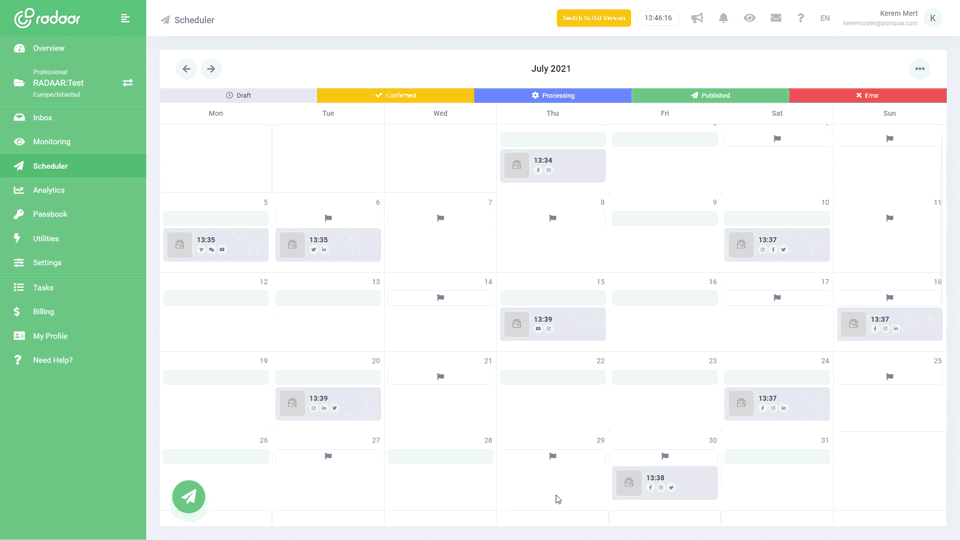Have you ever wondered if your marketing is missing the mark and how to truly discover who your target audience is?
Are you unsure if your marketing truly reaches the right people? Discover how to find your real target audience with practical steps and real-life examples—read on to make your marketing more effective.
LEARN MORE LAUNCH DEMO NOW Have you ever felt frustrated seeing your marketing efforts go unnoticed, or wondered why your campaigns don’t seem to connect with the people you hoped to reach? You’re not alone—and the culprit is often a hazy or misunderstood target audience. In today’s noisy digital world, no brand can afford to broadcast generic messages and hope they stick. Pinpointing your true audience is the difference between wasted budget and impactful, sustainable business growth.
This blog post unpacks the process of target audience analysis, guiding you step-by-step to identify exactly who you’re talking to. We’ll cover clear definitions, the difference between a target market and a target audience, and multiple segmentation types—from demographics to values. Plus, we’ll share real-life brand examples so you can see exactly how leading businesses hone their messaging. Ready to find your audience and make your marketing count? Let’s dive in.
This blog post unpacks the process of target audience analysis, guiding you step-by-step to identify exactly who you’re talking to. We’ll cover clear definitions, the difference between a target market and a target audience, and multiple segmentation types—from demographics to values. Plus, we’ll share real-life brand examples so you can see exactly how leading businesses hone their messaging. Ready to find your audience and make your marketing count? Let’s dive in.
Table of Contents
- What does target audience mean for your brand?
- How do target audience and target market differ?
- Which types of target audiences should you know?
- How can demographics shape your audience approach?
- Should you focus on interests and values more?
- How does customer journey data reveal key insights?
- Which tools truly help define your target audience?
- Why do real-life examples matter in audience targeting?
- Ready to define your audience and transform your marketing results today?
What does target audience mean for your brand?
A target audience is the specific group of people most likely to be interested in your brand’s products or services. Identifying your target audience helps you craft marketing messages that truly connect and inspire action. By focusing your marketing efforts on those who are most relevant, you maximize engagement and boost your ROI. Understanding your target audience is essential for shaping your brand’s identity and ensuring every campaign hits the mark.
How do target audience and target market differ?
The terms "target audience" and "target market" are often used interchangeably, but they have key differences in marketing strategy. The target market is the broader group of potential customers who might be interested in your product or service. In contrast, your target audience is a more specific segment within that market, defined by shared characteristics such as demographics, interests, or behaviors. Knowing the distinction helps you create focused messaging that resonates with the people most likely to engage with your brand.
Which types of target audiences should you know?
When it comes to identifying your target audience, understanding the different types you might encounter is essential for crafting successful marketing campaigns. The main types of target audiences include demographic groups (such as age, gender, income, and education), interests and hobbies, customer journey stages, subcultures or lifestyle groups, and values or beliefs. By recognizing these segments, you can tailor your messaging to resonate with the right people and ensure your marketing efforts don't fall flat. Each audience type brings unique preferences, behaviors, and motivations that influence their purchasing decisions.
For example, demographic segmentation helps you appeal to specific age groups or income brackets, while targeting based on interests allows you to focus on customers who are already passionate about topics related to your product. Addressing customer journey stages ensures you're meeting prospects where they are, whether they're just discovering your brand or ready to buy. Additionally, acknowledging subcultures and customer values can help build emotional connections and long-term loyalty. Knowing which audience type fits your product best is the key to effective audience targeting and successful marketing strategy.
For example, demographic segmentation helps you appeal to specific age groups or income brackets, while targeting based on interests allows you to focus on customers who are already passionate about topics related to your product. Addressing customer journey stages ensures you're meeting prospects where they are, whether they're just discovering your brand or ready to buy. Additionally, acknowledging subcultures and customer values can help build emotional connections and long-term loyalty. Knowing which audience type fits your product best is the key to effective audience targeting and successful marketing strategy.
How can demographics shape your audience approach?
Demographics are a powerful tool for shaping your marketing strategy, helping you to pinpoint who your target audience truly is. By segmenting your market according to attributes like age, gender, income, education, and location, you can tailor your campaigns to meet the needs of specific groups. For example, younger audiences on platforms like TikTok may respond well to meme-driven, lighthearted content, while professionals on LinkedIn might prefer more formal, data-backed information. Understanding these demographic details ensures your messaging resonates and increases the likelihood of engagement and conversions.
Moreover, demographic insights allow businesses to allocate budget wisely and avoid wasted marketing spend on uninterested segments. Utilizing market research data and analytics tools, you can identify which groups are most likely to benefit from your product or service. This enables you to craft relatable stories, address unique pain points, and even inform future product development. Harnessing the power of demographics means you’re not just casting a wide net—you’re reaching the audience that matters most to your brand.
Moreover, demographic insights allow businesses to allocate budget wisely and avoid wasted marketing spend on uninterested segments. Utilizing market research data and analytics tools, you can identify which groups are most likely to benefit from your product or service. This enables you to craft relatable stories, address unique pain points, and even inform future product development. Harnessing the power of demographics means you’re not just casting a wide net—you’re reaching the audience that matters most to your brand.
Should you focus on interests and values more?
Focusing on your audience’s interests and values can lead to stronger brand loyalty and more effective marketing campaigns. By understanding what your target audience cares about and how they spend their time, you can create messaging that truly resonates. Brands that align their marketing with customer values, such as sustainability or inclusivity, often see higher engagement and trust. Prioritizing these aspects over generic demographics helps build meaningful connections with your ideal customers.
How does customer journey data reveal key insights?
Customer journey data provides marketers with a map of every interaction a customer has with their brand, from initial discovery to post-purchase engagement. By carefully analyzing this journey, businesses can identify critical touchpoints where customers are most engaged and where they might drop off. This kind of data shines a light on what motivates customer actions, revealing preferences, hesitations, and needs that might otherwise go unnoticed. Leveraging these insights allows brands to fine-tune their messaging and offerings, ensuring each stage of the journey feels personalized and relevant.
Moreover, understanding the customer journey is essential for discovering your true target audience. By mapping real user behaviors and engagement patterns, organizations can uncover which types of customers are most likely to convert and remain loyal. This approach moves beyond assumptions or surface-level demographics, focusing instead on genuine actions and affinities. Ultimately, customer journey analysis empowers marketers to make data-driven decisions that foster stronger connections, increase retention, and drive successful campaigns.
Moreover, understanding the customer journey is essential for discovering your true target audience. By mapping real user behaviors and engagement patterns, organizations can uncover which types of customers are most likely to convert and remain loyal. This approach moves beyond assumptions or surface-level demographics, focusing instead on genuine actions and affinities. Ultimately, customer journey analysis empowers marketers to make data-driven decisions that foster stronger connections, increase retention, and drive successful campaigns.
Which tools truly help define your target audience?
To accurately define your target audience, a combination of digital analytics tools, social listening platforms, and customer surveys is essential. Tools like Google Analytics, HubSpot Analytics, and Facebook Insights provide valuable demographic and behavioral data about your website and social media visitors. Additionally, market research tools such as surveys and online polls help you gather direct feedback from your audience to better understand their preferences. Leveraging these insights ensures you tailor your marketing strategies to the right customers and maximize your impact.
Why do real-life examples matter in audience targeting?
Real-life examples in audience targeting offer actionable insights and bring abstract strategies to life. They help marketers understand what works (and what doesn’t) in practice, making it easier to relate concepts to their own brand. Case studies also inspire fresh ideas and build credibility by showcasing authentic outcomes. Using real examples ensures your marketing approach is grounded in proven tactics that connect with your target audience.
Ready to define your audience and transform your marketing results today?
Ready to define your audience and transform your marketing results today?
Understanding your target audience takes time, attention, and the right tools, but the payoff is worth it. When you know exactly who you’re speaking to, your marketing becomes more efficient, your campaigns see higher engagement, and your brand grows stronger connections with real customers. Don’t settle for generic messaging or wasted ad spend—start refining your targeting by analyzing data, asking for audience feedback, and revisiting your approach regularly. Every successful brand starts with a crystal-clear view of their audience, and you can achieve this, too.
If you want to make the process even easier, consider using tools like HubSpot Analytics, Google Analytics, or advanced social media management platforms. Gather deep insights about who interacts with your website and social channels, then put those learnings into action with campaigns tailored to specific segments. Start today by downloading our free Market Research Kit and unlock templates and guides to help you master your audience research. With actionable insights and a strategic mindset, you’ll transform your marketing results and build a brand customers truly connect with.
Understanding your target audience takes time, attention, and the right tools, but the payoff is worth it. When you know exactly who you’re speaking to, your marketing becomes more efficient, your campaigns see higher engagement, and your brand grows stronger connections with real customers. Don’t settle for generic messaging or wasted ad spend—start refining your targeting by analyzing data, asking for audience feedback, and revisiting your approach regularly. Every successful brand starts with a crystal-clear view of their audience, and you can achieve this, too.
If you want to make the process even easier, consider using tools like HubSpot Analytics, Google Analytics, or advanced social media management platforms. Gather deep insights about who interacts with your website and social channels, then put those learnings into action with campaigns tailored to specific segments. Start today by downloading our free Market Research Kit and unlock templates and guides to help you master your audience research. With actionable insights and a strategic mindset, you’ll transform your marketing results and build a brand customers truly connect with.
SOCIAL MEDIA SCHEDULER
Plan and publish...
Plan and publish your content for Facebook, Instagram, Twitter, and LinkedIn from one simple dashboard.
LEARN MORE FREQUENTLY ASKED QUESTIONS
Is your marketing missing the mark?
Find the answers to your target audience and marketing questions here. This FAQ section is designed to help you better understand, find, and connect with your ideal customers.
RELATED BLOG POSTS
All the tips & tricks you'll need...
Get the fresh tips and tricks you'll need to ace social media marketing.











